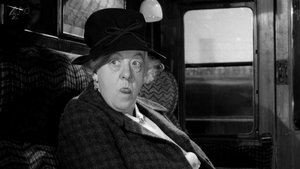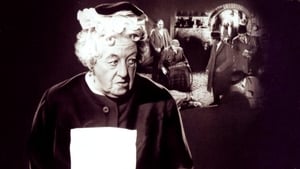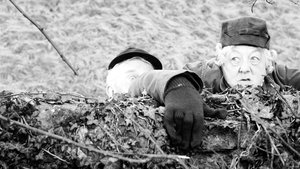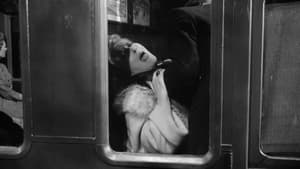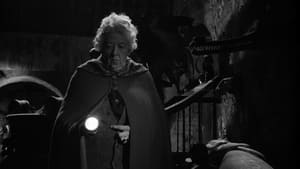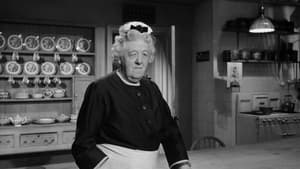Contact: info@alwanfilm.com
Video Sources 0 Views

Synopsis
Review: Murder She Said 1961 Colorized – A Classic Agatha Christie Mystery with a Touch of Humor

Introduction
“Murder She Said” (1961) stands as one of the most beloved adaptations of Agatha Christie’s work, capturing the wit, charm, and suspense that have made her stories timeless. Directed by George Pollock, the film is an adaptation of Christie’s novel 4.50 from Paddington, and it introduces the indomitable Margaret Rutherford as Miss Marple, a role that would define her career. In this article, we will delve into the significance of this classic mystery film, exploring its impact on the genre, the performances of its cast, and its lasting legacy in the world of cinema.
Check The Full Colorized Movies List
Check Our Colorized Movies Trailer Channel
Understanding Murder She Said 1961 Colorized: Director, Cast, and Genre
“Murder She Said” is a quintessential British mystery film, a genre that Agatha Christie helped to define with her prolific writing. Directed by George Pollock, who would go on to direct three more Miss Marple films with Rutherford, the movie is a blend of suspense, comedy, and classic whodunit elements. Pollock’s direction strikes a perfect balance between the tension of a murder mystery and the light-heartedness that Rutherford brings to the role of Miss Marple.
Margaret Rutherford, with her unique interpretation of Miss Marple, leads a cast that includes Arthur Kennedy as Harold Crackthorpe, and Muriel Pavlow as Emma Crackthorpe. Rutherford’s portrayal deviates from Christie’s original characterization of Marple as a frail, elderly woman, instead presenting her as a more robust and spirited amateur sleuth. This decision was initially controversial but has since become iconic, with Rutherford’s performance celebrated for its energy and wit.
The film’s genre, a mix of mystery and comedy, was relatively innovative at the time. While many adaptations of Christie’s work maintained a serious tone, “Murder She Said” introduced a lighter touch, which resonated with audiences and added a new dimension to the portrayal of classic detective stories on screen.
Exploring the World of Murder She Said 1961 Colorized: Plot and Characters
“Murder She Said” begins with a murder witnessed by Miss Marple as she travels on a train. Seated in a carriage, she happens to glance out of her window just as another train passes by, and she sees a woman being strangled. When she reports the crime, the police are skeptical, as no body is found and there are no other witnesses. Unperturbed, Miss Marple decides to investigate on her own, leading her to the sprawling estate of the Crackthorpe family.
The plot thickens as Miss Marple goes undercover as a maid at the Crackthorpe estate, uncovering secrets and lies that point to a deeper conspiracy. Each member of the Crackthorpe family becomes a suspect, with motives ranging from greed to jealousy. The film keeps the audience guessing until the very end, with a series of red herrings and clever twists that are a hallmark of Christie’s storytelling.
The character of Miss Marple is central to the film’s success. Margaret Rutherford’s interpretation of the amateur sleuth is both endearing and formidable, making her a character that audiences root for as she outsmarts both criminals and the police. Her interactions with the other characters, particularly Inspector Craddock (played by Charles Tingwell), provide some of the film’s most memorable moments, blending humor with the suspense of the investigation.
The Art of Adaptation: Bringing Agatha Christie to the Screen
Adapting a novel for the screen is always a challenge, particularly when dealing with the intricate plots and rich characterizations found in Agatha Christie’s work. “Murder She Said” succeeds by staying true to the essence of the source material while making necessary adjustments for the cinematic medium.
One of the key changes in the adaptation is the shift in tone. While Christie’s 4.50 from Paddington is a tense and somewhat grim tale, the film version introduces a lighter, more comedic touch. This change is largely attributed to the casting of Margaret Rutherford, whose performance injects humor into the story without undermining the suspense. The screenplay, written by David Pursall and Jack Seddon, skillfully balances these elements, ensuring that the mystery remains engaging while allowing for moments of levity.
The film also condenses and streamlines some aspects of the plot to fit within its runtime. While certain subplots and characters from the novel are either altered or omitted, the core mystery remains intact. These changes are a testament to the filmmakers’ understanding of the medium, recognizing that what works on the page may need to be reimagined for the screen.
The Legacy of Murder She Said 1961 Colorized
“Murder She Said” has left an indelible mark on the mystery genre, particularly in its influence on how Agatha Christie’s work has been adapted for film and television. The film’s success spawned three sequels, all starring Rutherford as Miss Marple: Murder at the Gallop (1963), Murder Most Foul (1964), and Murder Ahoy! (1964). These films solidified Rutherford’s place in cinematic history and introduced a new generation to Christie’s mysteries.
The film’s impact extends beyond its immediate sequels. It helped to establish a template for future adaptations of Christie’s work, where the balance of suspense and humor became a defining feature. This approach can be seen in later adaptations, including the long-running British television series Agatha Christie’s Miss Marple, where different actresses brought their own interpretations to the character, but often with a nod to Rutherford’s portrayal.
Furthermore, “Murder She Said” contributed to the broader popularity of the cozy mystery genre, characterized by a small-town setting, an amateur sleuth, and a tone that mixes intrigue with a certain charm and comfort. This genre has continued to thrive in both literature and film, with Miss Marple remaining one of its most beloved figures.
Themes Explored in Murder She Said 1961 Colorized
While “Murder She Said” is first and foremost a murder mystery, it also explores themes of justice, morality, and the role of women in society. Miss Marple, as an older woman, is often underestimated by those around her, yet she consistently proves herself to be the most insightful and capable character in the story. This theme of underestimation is common in Christie’s work, where characters who seem inconspicuous or harmless are often revealed to be the most astute.
The film also touches on the theme of class, particularly in its depiction of the Crackthorpe family and their sprawling estate. The family’s wealth and status do not protect them from suspicion, nor do they make them immune to the darker impulses that drive the plot. Through Miss Marple’s interactions with the family and the staff, the film subtly critiques the social hierarchies that were prevalent in British society at the time.
Another key theme is the idea of justice. Miss Marple’s pursuit of the truth is driven by a strong moral compass and a desire to see justice done, even when the official authorities are unwilling or unable to act. This reflects a broader theme in Christie’s work, where justice is often served through the determination and cleverness of her protagonists, rather than through the conventional legal system.
The Reception and Impact of Murder She Said 1961 Colorized
Upon its release in 1961, “Murder She Said” received positive reviews from both critics and audiences. Margaret Rutherford’s performance was widely praised, with many critics noting that she brought a refreshing energy and humor to the role of Miss Marple. The film’s success at the box office led to the creation of the aforementioned sequels, further cementing its place in the pantheon of great mystery films.
The impact of “Murder She Said” extends beyond its initial release. Over the decades, the film has continued to be a favorite among fans of Agatha Christie and classic cinema. Its influence can be seen in numerous other adaptations of Christie’s work, as well as in the broader mystery genre.
The film also played a significant role in shaping the public’s perception of Miss Marple. While Christie’s original portrayal of the character was more subdued, Rutherford’s energetic and humorous take became iconic, influencing how the character was portrayed in subsequent adaptations. This version of Miss Marple, with her sharp wit and unassuming demeanor, has become one of the most beloved figures in the history of detective fiction.
Where to Watch Murder She Said 1961 Colorized Online
For those interested in watching “Murder She Said,” the film is widely available on various streaming platforms. Classic film enthusiasts can find it on platforms like Amazon Prime Video, where it can be rented or purchased. Additionally, the film is often included in collections of Agatha Christie adaptations, available on DVD and Blu-ray, making it accessible to both new viewers and longtime fans.
FAQs About Murder She Said 1961 Colorized
Q: How does “Murder She Said” differ from the original Agatha Christie novel?
A: While “Murder She Said” is based on Christie’s novel 4.50 from Paddington, there are several differences between the film and the book. The film introduces a more humorous tone, largely due to Margaret Rutherford’s portrayal of Miss Marple, and some plot elements have been streamlined or altered for the sake of pacing and runtime.
Q: Why was Margaret Rutherford cast as Miss Marple, and how was her portrayal received?
A: Margaret Rutherford was cast as Miss Marple despite being physically and temperamentally different from Christie’s original character. Her portrayal was initially met with some skepticism, but it quickly became iconic, with audiences and critics praising her unique blend of humor and determination.
Q: Are there any other notable adaptations of 4.50 from Paddington?
A: Yes, 4.50 from Paddington has been adapted several times, including a 1987 television movie starring Joan Hickson as Miss Marple, and a 2004 adaptation featuring Geraldine McEwan in the role. Each adaptation offers a different interpretation of the story and character.
Q: How did “Murder She Said” influence subsequent Miss Marple films?
A: “Murder She Said” set the tone for the three sequels that followed, all starring Margaret Rutherford. The success of the film established a template for blending humor and mystery in Christie adaptations, which has influenced many subsequent films and television series.
Conclusion
“Murder She Said” (1961) remains a beloved classic in the world of mystery cinema, thanks in large part to Margaret Rutherford’s unforgettable portrayal of Miss Marple. The film’s blend of suspense, humor, and clever storytelling has ensured its place in the hearts of Agatha Christie fans and classic film enthusiasts alike. As we revisit this cinematic gem, it’s clear that its legacy endures, not just as an adaptation of a great mystery novel, but as a testament to the enduring appeal of a well-told detective story.
Whether you’re a longtime fan of Christie’s work or discovering it for the first time, “Murder She Said” offers a delightful and thrilling ride that continues to captivate audiences more than six decades after its release.
